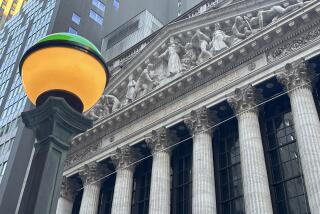Dow Rebounds to New High as Yields Fall
A fresh decline in bond yields and another wave of strong corporate earnings reports sent the Dow Jones industrials to a new high Wednesday.
The blue-chip index surged 50.57 points, or nearly 1%, to 5,242.84, pulling the broad market higher as well--although no other major stock indexes joined the Dow at record levels.
Meanwhile, the dollar rose to a 23-month high against the Japanese yen, bolstered by the first drop in Japan’s annual trade surplus in five years.
The Dow’s advance, after a 27-point drop Tuesday, was fueled initially by falling bond yields, after two reports added to the weight of recent evidence pointing to a sharply decelerating U.S. economy. Industrial production edged up just 0.1% in December, below expectations, and new-home sales in November fell to the lowest level in seven months.
The reports appeared to increase the likelihood of another cut in short-term interest rates by the Federal Reserve Board when it meets Tuesday.
What’s more, some traders said the market’s mood improved after Republican leaders in Congress said they would draft bills to keep the government running and avoid a default on the national debt.
Treasury Secretary Robert Rubin had spooked the market on Monday by warning that default was inevitable by March 1 if Congress continued to use the national debt ceiling as leverage in the fight with President Clinton over a balanced budget plan.
Although bonds rallied Wednesday, however, the advance was trimmed late in the day after bond-rating giant Moody’s Investors Service said it was placing $387 billion of Treasury securities with interest payments due Feb. 29 and April 6 “on review for possible downgrade” of credit quality.
Treasury securities now are considered among the world’s safest investments, rated Aaa by Moody’s, the highest possible rating. A downgrade of even a portion of the Treasury’s bonds would be a stunning blow to the U.S. government’s credit-worthiness.
On Wednesday, the 30-year Treasury bond yield fell as low as 6.01% from 6.09% on Tuesday, but inched higher after the Moody’s announcement to close at 6.03%.
At the Treasury’s auction of $12 billion of new five-year notes the average yield was 5.36%, somewhat above expectations.
On Wall Street, stocks’ gains were powered not only by lower interest rates but also by another batch of healthy fourth-quarter corporate earnings reports.
For the first time in many sessions, advancing issues had a strong lead over decliners on the Big Board, outpacing them by 1,483 to 900 in heavy trading.
The Standard & Poor’s 500 index shot up 7.17 points, or 1.2%, to 619.96. The Nasdaq composite index gained 15.42 points, or 1.5%, to 1,043.46.
“The market is anticipating lower interest rates on the one hand, and on the other is pleasantly surprised by some of these earnings being better than expected,” said Thom Brown, money manager at Rutherford, Brown & Catherwood, which manages $270 million.
Among Wednesday’s highlights:
* Earnings report boosted defense giant United Technologies, up 3 1/8 to 97 3/8; chemical leader DuPont, up 2 1/8 to 74 1/8; and health-care products maker Johnson & Johnson, which surged 6 to a record high 93 3/4.
* IBM and Digital Equipment, both of which reported surprisingly strong earnings in recent days, led the technology sector higher. IBM leaped 4 to 107, nearing its 1995 high of 114 5/8; Digital surged 3 1/8 to a new 52-week high of 73 1/8.
Other tech winners included Intel, up 2 1/16 to 54 3/4; Hewlett-Packard, up 3 1/2 to 84; Micron Technology, up 5 to 37; Oracle, up 2 7/8 to 49 1/8; and BMC Software, up 8 1/2 to 51 3/4 after the mainframe-computer software firm reported higher-than-expected earnings.
Analysts said tech stocks’ rebound is a function of better earnings reports and “short covering” by traders who had correctly bet on the stocks’ recent dive and now are closing out their bets by buying the stocks on the open market.
* On the down side, personal computer maker Compaq fell 1 7/8 to 47 3/4. Its fourth-quarter earnings rose 33% before special items but the firm warned of pressure on profit margins. Also, Xerox slumped 15 to 126 5/8. It reported weaker-than-expected quarterly growth in its core copier business.
* Amid rumored takeover stocks, Helene Curtis soared 12 3/4 to 65 7/8, bringing its two-day gain to 21. The personal-care products said it is talking with unnamed suitors about being acquired.
Last week, Burbank investment fund Shamrock Holdings, which owns 7.6% of Helene Curtis, suggested to the company that it put itself up for sale.
Helene Curtis’ announcement helped boost other consumer brand-name stocks, including Clorox, up 3 3/4 to 82 3/8; Alberto-Culver, up 2 7/8 to 38 7/8; and Avon Products, up 2 5/8 to 78 1/4.
In currency trading, the reported 17% decline in Japan’s annual trade surplus with the United States pushed the dollar up as high as 107.18 yen, highest since Feb. 11, 1994. The dollar ended up 1.09 yen at 106.93 in New York.
The dollar also rose against European currencies after Germany’s Bundesbank cut a key money-market rate, prompting central banks in Belgium, Denmark and the Netherlands to follow suit. The dollar ended at 1.4825 German marks, up from 1.4789 Tuesday.
More to Read
Inside the business of entertainment
The Wide Shot brings you news, analysis and insights on everything from streaming wars to production — and what it all means for the future.
You may occasionally receive promotional content from the Los Angeles Times.










